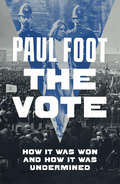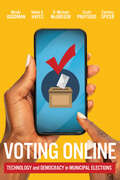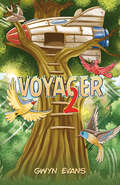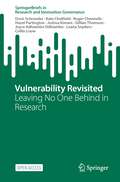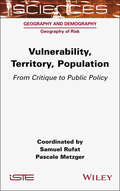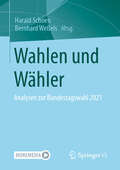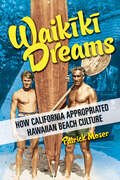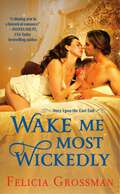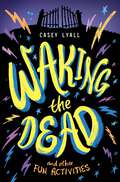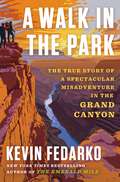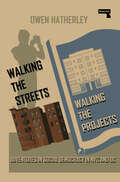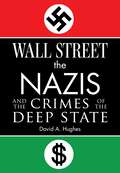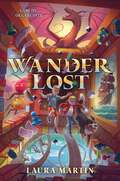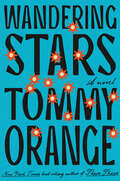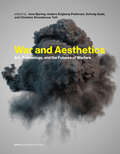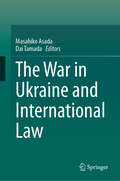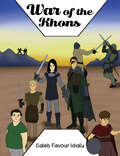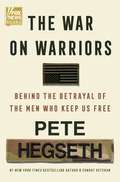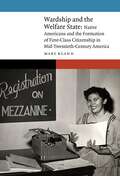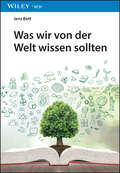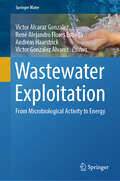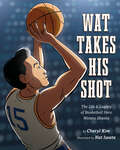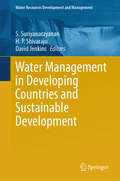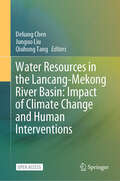- Table View
- List View
The Vote: How It Was Won and How It Was Undermined
by Paul FootThe dramatic story of the peoples' fight for the right to vote in BritainThe culmination of a lifetime's work by the great journalist and historian Paul Foot, The Vote tells the thrilling story of the hard, long-fought struggle for the right to vote in Britain, and the slow erosion that followed.In the tradition of "history from below," Paul Foot examines the great democratic debates that dominated the fight for electoral democracy. Taking readers from the smoke-filled church of the Putney debates, to the dramatic arguments between Thomas Paine and Edmund Burke in the aftermath of the French Revolution, to the rise of Chartism and the struggles for votes for women.Throughout, Foot shows how vested interested first delayed and then hobbled the progress of parliamentary democracy. Concentrating on the vital role played by direct action, he shows how rank-and-file resistance to ruling-class injustice was followed by retreat into parliamentary impotence. Into the twentieth-century, Foot exposes the gaps between the promises of a succession of Labour governments and their actions once in power, and its abandonment of any aspiration to economic democracy.A gripping work of narrative history, written in Paul Foot's inimitable energy and engaged style, this book is a classic work of history, and a must-read for anyone interested in how today's political scene was formed.
Voting Online: Technology and Democracy in Municipal Elections (McGill-Queen's Studies in Urban Governance)
by Zachary Spicer Scott Pruysers Nicole Goodman R. Michael McGregor Helen A. HayesIn an attempt to reverse declining rates of voter participation, governments around the world are turning to electronic voting to improve the efficiency of vote counts, and increase the accessibility and equity of the voting process for electors who may face additional barriers. The Covid-19 pandemic has intensified this trend.Voting Online focuses on Canada, where the technology has been widely embraced by municipal governments with one of the highest rates of use in the world. In the age of cyber elections, Canada is the only country where governments offer fully remote electronic elections and where traditional paper voting is eliminated for entire electorates. Municipalities are the laboratories of electoral modernization when it comes to digital voting reform. We know conspicuously little about the effects of these changes, particularly the elimination of paper ballots.Relying on surveys of voters, non-voters, and candidates in twenty Ontario cities, and a survey of administrators across the province of Ontario, Voting Online provides a holistic view of electronic elections unavailable anywhere else.
Voyager 2
by Gwyn EvansJoin Tod the squirrel and his woodland friends on an exciting adventure as they build their very own spaceship-shaped treehouse! With the help of their new neighbours, the weasel brothers Sammy and Jimmy, they paint their creation in vibrant red, blue, and silver. But the fun doesn't stop there – a wise old raven named Zander takes the friends on thrilling flights through the sky. Filled with laughter, friendship, and colourful illustrations, Voyager 2 is a delightful tale that will spark the imagination of young readers as they follow these lovable characters on their quest to build the treehouse of their dreams.
Vulnerability Revisited: Leaving No One Behind in Research (SpringerBriefs in Research and Innovation Governance)
by Doris Schroeder Roger Chennells Kate Chatfield Hazel Partington Joshua Kimani Gillian Thomson Joyce Adhiambo Odhiambo Leana Snyders Collin LouwOpen access. This open-access book discusses vulnerability and the protection-inclusion dilemma of including those who suffer from serious poverty, severe stigma, and structural violence in research. Co-written with representatives from indigenous peoples in South Africa and sex workers in Nairobi, the authors come down firmly on the side of inclusion. In the spirit of leaving no one behind in research, the team experimented with data collection methods that prioritize research participant needs over researcher needs. This involved foregoing the collection of personal data and community researchers being involved in all stages of the research. In the process, the term ‘vulnerability’ was illuminated across significant language barriers as it was defined by indigenous peoples and sex workers themselves. The book describes a potential alternative to exclusion from research that moves away from traditional research methods. By ensuring that the research is led by vulnerable groups for vulnerable groups, it offers an approach that fosters trust and collaboration with benefits for the community researchers, the wider community as well as research academics. Those living in low-income settings, in dire situations that are summarized with the term ‘vulnerability’ know best what their problems are and which priorities they have. To exclude them from research for their own protection is a patronizing approach which insinuates that researchers and research ethics committees know best. The team from this book have shown that minimally risky and minimally burdensome research tailored towards the needs of highly marginalized and stigmatized communities can be scientifically valuable as well as inclusive and equitable. I congratulate them. Prof. Klaus Leisinger, President Global Values Alliance, Former personal advisor to Kofi Annan on corporate responsibility
Vulnerability, Territory, Population: From Critique to Public Policy
by Samuel Rufat Pascale MetzgerDuring the Covid-19 pandemic, the term "vulnerable" was applied to "individuals" and to "populations", "groups" and "countries" in discussions, laws and regulations; now it applies to all objects in relation to all kinds of threats. However, rather than a label for governing people and places, the notion of "vulnerability" was expected to become an instrument to tackle the root causes of disasters, poverty and maldevelopment, as well as the inequalities and injustices they bring, whether social, political, economic or environmental. Despite this radical dimension, vulnerability has gradually been incorporated into public policies and international recommendations for global risk and disaster management. This book is intended for researchers, students, managers and decision makers concerned with the management of not only risks and crises but also climate and environmental change. The first part examines the multiple theoretical and conceptual approaches; the second explores vulnerability assessments, using examples from the Global North and Global South; and the third discusses tools, public policies and actions taken to reduce vulnerability.
Wahlen und Wähler: Analysen zur Bundestagswahl 2021
by Harald Schoen Bernhard WeßelsDer Band bündelt Analysen führender Wahlforscherinnen und Wahlforscher sowie Politikwissenschaftlerinnen und Politikwissenschaftler aus Deutschland zur Bundestagswahl 2021. Der Band ist die Fortsetzung der sogenannten „Blauen Bände“, die seit ihrem Beginn 1980 umfassend und systematisch Analysen zu allen Bundestagswahlen und zu international relevanten Ergebnissen der Wahlforschung zusammenfasst.
Waikiki Dreams: How California Appropriated Hawaiian Beach Culture (Sport and Society)
by Patrick MoserDespite a genuine admiration for Native Hawaiian culture, white Californians of the 1930s ignored authentic relationships with Native Hawaiians. Surfing became a central part of what emerged instead: a beach culture of dressing, dancing, and acting like an Indigenous people whites idealized. Patrick Moser uses surfing to open a door on the cultural appropriation practiced by Depression-era Californians against a backdrop of settler colonialism and white nationalism. Recreating the imagined leisure and romance of life in Waikīkī attracted people buffeted by economic crisis and dislocation. California-manufactured objects like surfboards became a physical manifestation of a dream that, for all its charms, emerged from a white impulse to both remove and replace Indigenous peoples. Moser traces the rise of beach culture through the lives of trendsetters Tom Blake, John “Doc” Ball, Preston “Pete” Peterson, Mary Ann Hawkins, and Lorrin “Whitey” Harrison while also delving into California’s control over images of Native Hawaiians via movies, tourism, and the surfboard industry. Compelling and innovative, Waikīkī Dreams opens up the origins of a defining California subculture.
Wake Me Most Wickedly (Once Upon the East End)
by Felicia GrossmanA New York Times Best Romance (So Far!) of 2024 &“No one writes love stories with more heart, more swoons, and more sizzle&” (Joanna Shupe, USA Today bestselling author) in this clever reimaging of Snow White, where a handsome businessman will do anything to win the heart of the only woman he cannot have. Solomon Weiss has little interest in power, but to repay the half-brother who raised him, he pursues money, influence, and now—a respectable wife. That is, until outcast Hannah Moses saves his life, and Sol finds himself helplessly drawn to the beautiful pawnshop owner. Forever tainted by her parents' crimes, Hannah sees only a villain when she looks in the mirror—no one a prince would choose. To survive, she must care for herself, even if that means illegally hunting down whatever her clients wish. So, no matter how fair or charming she finds Sol, he belongs to a world far too distant from her own. Only neither can resist their desires, and each meeting weakens Hannah&’s resolve to stay away. But when Hannah discovers a shocking betrayal in Sol&’s inner circle, can she convince him to trust her? Or will fear and doubt poison their love for good?
Waking the Dead and Other Fun Activities
by Casey LyallSometimes it’s hard to rest in peace. A young trainee witch, a family power gone haywire, a dearly departed grandma, an undead boy, and an evil witch—that’s a recipe for the perfect summer vacation. Both hilarious and heartfelt, this fast-paced mystery about life and death (and afterlife) is for fans of Spirit Hunters and The Miscalculations of Lightning Girl.Twelve-year-old Kimmy Jones wants to excel at the unique (and secret) aspect of her family’s funeral home business. Under the watchful eye of Grandma Bev, Kimmy learns how to raise the recently deceased, request their last wish, and break the connection to send them on. But when Grandma unexpectedly dies herself, Kimmy can’t reach her spirit, and nothing seems like it’s ever going to be right again.Then a boy dies under mysterious circumstances on the night of a meteor shower. With no witnesses, Kimmy’s the only one who can get answers about what happened. So she breaks into the hospital morgue, and for the first time in months, her power works. She Wakes the boy up. Except then Kimmy can’t break the connection and so he stays Awake. Even worse, the boy has no memory of what happened to him. As Kimmy works to unravel the mystery, she discovers secrets about her heritage and learns about a witch who has been wreaking havoc for centuries.Casey Lyall’s supernatural mystery is heartfelt, thrilling, and hilarious. Waking the Dead and Other Fun Activities is perfect for fans of Avi’s School of the Dead and Suzanne Young’s What Stays Buried.
A Walk in the Park: The True Story of a Spectacular Misadventure in the Grand Canyon
by Kevin FedarkoTwo friends, zero preparation, one dream. From the author of the beloved bestseller The Emerald Mile, a rollicking and poignant account of the epic misadventure of a 750-mile odyssey, on foot, through the heart of America&’s most magnificent national park and the grandest wilderness on earth.A few years after quitting his job to follow an ill-advised dream of becoming a guide on the Colorado River, Kevin Fedarko was approached by his best friend, the National Geographic photographer Pete McBride, with a vision as bold as it was harebrained. Together, they would embark on an end-to-end traverse of the Grand Canyon, a journey that, McBride promised, would be &“a walk in the park.&” Against his better judgment, Fedarko agreed to the scheme, unaware that the small cluster of experts who had completed the crossing billed it as &“the toughest hike in the world.&” The ensuing ordeal, which lasted more than a year, revealed a place that was deeper, richer, and far more complex than anything the two men had imagined—and came within a hair&’s breadth of killing them both. They struggled to make their way through the all but impenetrable reaches of its truest wilderness, a vertical labyrinth of thousand-foot cliffs and crumbling ledges where water is measured out by the teaspoon and every step is fraught with peril—and where, even today, there is still no trail along the length of the country&’s best-known and most iconic park. Along the way, veteran long-distance hikers ushered them into secret pockets, invisible to the millions of tourists gathered on the rim, where only a handful of humans have ever laid eyes. Members of the canyon&’s eleven Native American tribes brought them face-to-face with layers of history that forced them to reconsider myths at the center of our national parks—and exposed them to the impinging threats of commercial tourism. Even Fedarko&’s dying father, who had first pointed him toward the canyon more than forty years earlier but had never set foot there himself, opened him to a new way of seeing the landscape. And always, there was the great gorge itself: austere and unforgiving but suffused with magic, drenched in wonder, and redeemed by its own transcendent beauty. A Walk in the Park is a singular portrait of a sublime place, and a deeply moving plea for the preservation of America&’s greatest natural treasure.
Walking the Streets/Walking the Projects: Adventures in Social Democracy in NYC and DC
by Owen HatherleyA walk through the remnants of a social democratic America, and an argument about its future.In the 1960s, a novel ideology about cities, and what was best for them, emerged in New York. Pushing against the state planning of the time, it held that cities were at their best when they were driven from the bottom-up and when organic, unplanned processes were allowed to run their course, in a spontaneous "ballet of the street". Cities were at their worst, however, when the state stepped in, demolishing lively old neighbourhoods and erecting giant, sterile, empty "projects". This book uses the method of this ideology — walking — to test how true it actually is about the "capital of the twentieth century", New York City, with a brief interlude in the capital, Washington DC.The "projects" that are walked in this book range from cultural complexes in Manhattan to New Deal-era public housing developments in Brooklyn, Harlem and Queens, from the social experiment of Roosevelt Island to Communist housing co-operatives in the Bronx, from the union-driven rebuilding of the Lower East Side to DC's magnificent Metro. For all their many flaws, they prove that Americans could, in fact, plan and build fragments of a better society, which survive and sometimes thrive today in one of the unequal places on earth. Walking the Streets/Walking the Projects takes a hard look at these enclaves, and asks what a new generation of American socialists might be able to learn from them.
Wall Street, the Nazis, and the Crimes of the Deep State
by David HughesThe transnationally coordinated response to "Covid-19" witnessed numerous developments reminiscent of the prewar years of the Third Reich, including the suspension of constitutional rights and freedoms, the rollout of draconian legislation, an attempted revolution from above (the "Great Reset"), the censorship of dissent, health surveillance, euthanasia, eugenics, the corruption of science by politics, and the hijacking of conscience. The list goes on. "Never again!" was the rallying cry after 1945, yet never again is now global. How did we get here? Wall Street, the Nazis, and the Crimes of the Deep State explores the role of Wall Street in promoting the rise of Hitler, funding the Nazi war machine, recruiting and rehabilitating ex-Nazis, and creating a transnational deep state inspired by Nazi methods. Wall Street has long preferred totalitarianism as the regime type most effective in crushing working-class resistance, and as capitalism once more enters a period of acute crisis, the aim is to replace liberal democracy with global technocracy—a novel, biodigital form of totalitarianism whose potential for social control exceeds anything imaginable by Hitler or Stalin.Wall Street, the Nazis, and the Crimes of the Deep State illustrates how totalitarianism does not spring into existence fully formed. In the case of Nazi Germany, the descent into barbarism took place gradually, over many years. Today, the warning signs from history are flashing red. Unless the global technocratic coup being attempted is put down, we can expect the centralization of power in a New World Order, the return of slavery, the privatization of the global commons, and the transformation of society into a biodigital camp, bringing an end to the rule of law and normalizing the use of eugenics and a systematic mass murder of dissidents.
Wander Lost
by Laura MartinFrom the critically acclaimed author of Float and Glitch comes a new stand-alone adventure full of humor and heart, perfect for fans of Gordon Korman and Dan Gutman!Rhett and his brother, Nash, have never been allowed to play board games. It's their mom's most important rule; the twins don't know why, but they know not to push her on it.When their mom suddenly disappears, they're reunited with Ace, their long-lost grandfather, who reveals that their family is descended from a board game character who escaped his game and lived in the real world. Their family now has the ability to enter the world of any game they want—but this gift also comes with a price. A game character who’s wanted revenge against their mom for decades has finally caught her and is holding her hostage in the world of a game. Which game? That’s up to Rhett and Nash to figure out, even if it means breaking Mom’s most important rule.But as they learn to use their newly discovered ability, exploring new worlds and facing new challenges and risks, the brothers quickly realize that saving Mom won't be all fun and games. It’s game on… or game over.
Wandering Stars: A novel
by Tommy OrangeNEW YORK TIMES BESTSELLER • NAMED A BEST BOOK OF THE YEAR SO FAR FOR 2024 BY THE NEW YORK TIMES BOOK REVIEW • The Pulitzer Prize-finalist and author of the breakout bestseller There There ("Pure soaring beauty."The New York Times Book Review) delivers a masterful follow-up to his already classic first novel. Extending his constellation of narratives into the past and future, Tommy Orange traces the legacies of the Sand Creek Massacre of 1864 and the Carlisle Indian Industrial School through three generations of a family in a story that is by turns shattering and wondrous."For the sake of knowing, of understanding, Wandering Stars blew my heart into a thousand pieces and put it all back together again. This is a masterwork that will not be forgotten, a masterwork that will forever be part of you.&” —Morgan Talty, bestselling author of Night of the Living RezColorado, 1864. Star, a young survivor of the Sand Creek Massacre, is brought to the Fort Marion prison castle,where he is forced to learn English and practice Christianity by Richard Henry Pratt, an evangelical prison guard who will go on to found the Carlisle Indian Industrial School, an institution dedicated to the eradication of Native history, culture, and identity. A generation later, Star&’s son, Charles, is sent to the school, where he is brutalized by the man who was once his father&’s jailer. Under Pratt&’s harsh treatment, Charles clings to moments he shares with a young fellow student, Opal Viola, as the two envision a future away from the institutional violence that follows their bloodlines.In a novel that is by turns shattering and wondrous, Tommy Orange has conjured the ancestors of the family readers first fell in love with in There There—warriors, drunks, outlaws, addicts—asking what it means to bethe children and grandchildren of massacre. Wandering Stars is a novel about epigenetic and generational trauma that has the force and vision of a modern epic, an exceptionally powerful new book from one of the most exciting writers at work today and soaring confirmation of Tommy Orange&’s monumental gifts.
War and Aesthetics: Art, Technology, and the Futures of Warfare (Prisms: Humanities and War #1)
by Jens Bjering, Anders Engberg-Pedersen, Solveig Gade, and Christine Strandmose ToftA provocative edited collection that takes an original approach toward the black box of military technology, surveillance, and AI—and reveals the aesthetic dimension of warfare.War and Aesthetics gathers leading artists, political scientists, and scholars to outline the aesthetic dimension of warfare and offer a novel perspective on its contemporary character and the construction of its potential futures. Edited by a team of four scholars, Jens Bjering, Anders Engberg-Pedersen, Solveig Gade, and Christine Strandmose Toft, this timely volume examines warfare through the lens of aesthetics, arguing that the aesthetic configurations of perception, technology, and time are central to the artistic engagement with warfare, just as they are key to military AI, weaponry, and satellite surveillance.People mostly think of war as the violent manifestation of a political rationality. But when war is viewed through the lens of aesthesis—meaning perception and sensibility—military technology becomes an applied science of sensory cognition. An outgrowth of three war seminars that took place in Copenhagen between 2018 and 2021, War and Aesthetics engages in three main areas of inquiry—the rethinking of aesthetics in the field of art and in the military sphere; the exploration of techno-aesthetics and the wider political and theoretical implications of war technology; and finally, the analysis of future temporalities that these technologies produce. The editors gather various traditions and perspectives ranging from literature to media studies to international relations, creating a unique historical and scientific approach that broadly traces the entanglement of war and aesthetics across the arts, social sciences, and humanities from ancient times to the present. As international conflict looms between superpowers, War and Aesthetics presents new and illuminating ways to think about future conflict in a world where violence is only ever a few steps away.ContributorsLouise Amoore, Ryan Bishop, Jens Bjering, James Der Derian, Anthony Downey, Anders Engberg-Pedersen, Solveig Gade, Mark B. Hansen, Caroline Holmqvist, Vivienne Jabri, Caren Kaplan, Phil Klay, Kate McLoughlin, Elaine Scarry, Christine Strandmose Toft, Joseph Vogl, Arkadi Zaides
The War in Ukraine and International Law
by Dai Tamada Masahiko AsadaThe war in Ukraine is fast approaching its second anniversary since its commencement on 24 February 2022 as a blatant aggression by Russia. As we discuss in detail in this book, there are multiple international legal issues that arise and require addressing. What is more, the very international legal order is under threat, insofar as the fundamental international law obligations are not being complied with and the basic international rules are utterly ignored. This book discusses a number of international law issues arising from the war in Ukraine. It covers not only the traditional subjects of war, such as jus ad bellum, international criminal law, and the law of neutrality, but also the relatively new issues arising from the economic sanctions against Russia, including aspects of the WTO law and international investment law. This book provides the readers with opportunities to reconsider the various legal aspects of the war in Ukraine.
War of the Khons
by Caleb Favour IdialuIn a distant future, the world is under the tyrannical rule of the evil overlord Enzo and his army, along with the mad scientist Mezro. Three brave heroes – Mary, Paul, and Joe – rise up to challenge their oppressors. Armed with makeshift weapons, they embark on a perilous mission to infiltrate Enzo’s stronghold and take down his empire. However, a tragic turn of events leaves Paul badly injured, and he is left for dead as Mary and Joe make their escape. This captivating story is brought to life through a combination of vivid text and stunning, stylishly colored illustrations that immerse the reader in the action. Years later, Paul resurfaces as a powerful cyborg, hell-bent on exacting revenge on Mary. As new villains emerge and old enemies return, the stage is set for an epic final battle that will determine the fate of the world. Alliances are formed, and rivalries are born as the heroes and villains clash in a desperate struggle for power. With pulse-pounding action, plot twists, and a richly imagined future world, War of the Khons is a thrilling science fiction adventure that will keep readers on the edge of their seats until the very last page. The book’s vibrant artwork perfectly complements the gripping narrative, making it a truly immersive experience for readers of all ages.
The War on Warriors: Behind the Betrayal of the Men Who Keep Us Free
by Pete HegsethReal men fought for our freedoms. It’s time we fought for theirs. <P><P> Pete Hegseth joined the Army to fight extremists. Then that same Army called him one. The military Pete joined twenty years ago was fiercely focused on lethality, competency, and color blindness. Today our brass are following the rest of our country off the cliff of cultural chaos and weakness. <P><P> Americans with common sense are fighting this on many fronts, but if we can’t save the meritocracy of our military, we’re definitely going to lose everywhere else. <P><P> The War on Warriors uncovers the deep roots of our dysfunction—a society that has forgotten the men who take risks, cut through red tape, and get their hands dirty. The only kind of men prepared to face the dangers that the Left pretends don’t exist. Unlike issues of education or taxes or crime, this problem doesn’t have a zip code solution. We can’t move away from it. We can’t avoid it. We have only one Pentagon. Either we take it back or surrender it altogether. <P><P> Combining his own war experiences, tales of outrage, and an incisive look at how the chain of command got so kinked, this book is the key to saving our warriors—and winning future wars. The War on Warriors must be won by the good guys, because when the shooting really starts, they’re the only ones who can save us. <p> <b>New York Times Bestseller</b>
The War We Won Apart: The Untold Story of Two Elite Agents Who Became One of the Most Decorated Couples of WWII
by Nahlah AyedLove, betrayal, and a secret war: the untold story of two elite agents, one Canadian, one British, who became one of the most decorated couples of WWII.On opposite sides of the pond, Sonia Butt, an adventurous young British woman, and Guy d&’Artois, a French-Canadian soldier and thunderstorm of a man, are preparing for war.From different worlds, their lives first intersect during clandestine training to become agents with Winston Churchill&’s secret army, the Special Operations Executive. As the world&’s deadliest conflict to date unfolds, Sonia and Guy learn how to parachute into enemy territory, how to kill, blow up rail lines, and eventually . . . how to love each other. But not long after their hasty marriage, their love is tested by separation, by a titanic invasion—and by indiscretion.Writing in vivid, heart-stopping prose, Ayed follows Sonia as she plunges into Nazi-occupied France and slinks into black market restaurants to throw off occupying Nazi forces, while at the same time participating in sabotage operations against them; and as Guy, in another corner of France, trains hundreds into a resistance army.Reconstructed from hours of unpublished interviews and hundreds of archival and personal documents, the story Ayed tells is about the ravaging costs of war paid for disproportionately by the young. But more than anything, The War We Won Apart is a story about love: two secret agents who were supposed to land in enemy territory together, but were fated to fight the war apart.
Wardship and the Welfare State: Native Americans and the Formation of First-Class Citizenship in Mid-Twentieth-Century America (New Visions in Native American and Indigenous Studies)
by Mary KlannWardship and the Welfare State examines the ideological dimensions and practical intersections of public policy and Native American citizenship, Indian wardship, and social welfare rights after World War II. By examining Native wardship&’s intersections with three pieces of mid-twentieth-century welfare legislation—the 1935 Social Security Act, the 1942 Servicemen&’s Dependents Allowance Act, and the 1944 GI Bill—Mary Klann traces the development of a new conception of first-class citizenship.Wardship and the Welfare State explores how policymakers and legislators have defined first-class citizenship against its apparent opposite, the much older and fraught idea of Indian wardship. Wards were considered dependent, while first-class citizens were considered independent. Wards were thought to receive gratuitous aid from the government, while first-class citizens were considered responsible. Critics of the federal welfare state&’s expansion in the 1930s through 1960s feared that as more Americans received government aid, they too could become dependent wards, victims of the poverty they saw on reservations. Because critics believed wardship prevented Native men and women from fulfilling expectations of work, family, and political membership, they advocated terminating Natives&’ trust relationships with the federal government. As these critics mistakenly equated wardship with welfare, state officials also prevented Native people from accessing needed welfare benefits. But to Native peoples wardship was not welfare and welfare was not wardship. Native nations and pan-Native organizations insisted on Natives&’ government-to-government relationships with the United States and maintained their rights to welfare benefits. In so doing, they rejected stereotyped portrayals of Natives&’ perpetual poverty and dependency and asserted and defined tribal sovereignty. By illuminating how assumptions about &“gratuitous&” government benefits limit citizenship, Wardship and the Welfare State connects Native people to larger histories of race, inequality, gender, and welfare in the twentieth-century United States.
Was wir von der Welt wissen sollten
by Jens BottDas Buch zum Mitreden in aktuellen Debatten in Wissenschaft und Gesellschaft Der Wunsch, die Welt verstehen zu wollen, ist so alt wie die Menschheit; wir suchen nach Erklärungen, benötigen Halt und Orientierung. Aus Annahmen und Überzeugungen, die uns plausibel erscheinen, formen wir unsere Weltbilder, Vorstellungen über die Beschaffenheit des Universums. Die jeweils herrschenden Vorstellungen haben sich mit der Zeit allerdings verändert. Bis zum Ende des Mittelalters lagen die Dinge noch einfach: Für die Menschen in Europa etwa war die Bibel die Quelle aller Wahrheit, ein universelles Sachbuch, das die Entstehung des Universums, die Artenvielfalt und den Ursprung des Sprachengewirrs erklärte, aber auch moralische Richtlinien vorgab. Mit der Zeit hat sich eine Reihe zentraler Theorien und Ideen herausgeschält, die den heutigen Wissenschafts-und Politikbetrieb prägen. Gleich, ob wir sie nun persönlich für richtig halten oder nicht, haben diese herrschenden Meinungen Einfluss auf unser tägliches Leben – und das mehr, als uns oftmals bewusst ist. Im ersten Teil des Buches (Die Natur) werden nach Darstellung der Grundlagendisziplin Mathematik zunächst die physikalischen Naturgesetze dargelegt, um dann zu zeigen, wie sich aus ihnen die Chemie und aus der Chemie die Biologie ergibt. Im Mittelpunkt stehen Newtons Mechanik, die Relativitätstheorie, die Quantenphysik und Darwins Evolutionstheorie. Das abschließende Kapitel erzählt die Naturgeschichte vom Urknall bis zum Erscheinen des Homo sapiens und fasst dabei die wesentlichen Aussagen noch einmal zusammen. Das erste Kapitel des zweiten Teils (Der Mensch) beschäftigt sich mit dem menschlichen Bewusstsein und leitet aus einer naturwissenschaftlichen Perspektive zu den geisteswissenschaftlichen Kapiteln Sprache (Ausdrucksform des Bewusstseins), Philosophie (Geschichte des Denkens), Gesellschaft (Theorie des Zusammenlebens) und Ökonomie (Umgang mit knappen Ressourcen) über. Das abschließende Kapitel erzählt die Menschheitsgeschichte bis heute, wobei wiederum die zentralen Aussagen noch einmal zusammengefasst werden.
Wastewater Exploitation: From Microbiological Activity to Energy (Springer Water)
by Andreas Haarstrick Victor Alcaraz Gonzalez René Alejandro Flores Estrella Victor Gonzalez AlvarezWith all the current efforts to use non-fossil sources as a starting point for future energy solutions, consideration is also being given to using microbial activities as a direct or indirect source of energy production. This ranges from the use of algae as biomass or as H2 producers, anaerobic microorganisms to produce methane, hydrogen, and even electricity directly. This book deals with both theoretical and technical possibilities of using anaerobic microorganisms in combination with wastewater as a substrate source to produce biofuels and bioenergy in the form of biomass, CH4 and H2 as well as the corresponding power densities and electricity quantities in economically justifiable processes. Unique process facilities are widely addressed; however, special interest is also placed in biorefinery and circular economy related concepts. The theoretical background as well as application examples are presented.
Wat Takes His Shot: The Life & Legacy of Basketball Hero Wataru Misaka
by Cheryl KimThe stirring biography of Japanese American basketball star Wataru Misaka--the first person of color to play in the NBA!As a kid, Wataru Misaka channeled his endless energy into playing sports. Every Sunday, he raced to the park where his Japanese American community came together to play basketball. Wat wasn't the tallest on the team, but he was fast and loved the game! Encouraged by his father to always do his best, Wat applied this mentality to every aspect and challenge in his life. Wat was a college student when the US government forced more than 122,000 Japanese Americans living on the West Coast into incarceration camps during WWII. He overcame racism and segregation to join his college's basketball team but despite Wat's impressive skills, he was treated as an outsider because he was Japanese American. Wat kept his eye on the ball, and his team-player mentality made him shine on and off the court. He became an inspiration to his Japanese American community. After helping Utah University's basketball team win the national championship in 1947, Wat was drafted by the New York Knicks, making him the first person of color to play in the NBA. Wat's motivational story of rising to any challenge and bringing your best to everything you do is a reminder of the power we each have to inspire others--if we just take our shot!
Water Management in Developing Countries and Sustainable Development (Water Resources Development and Management)
by David Jenkins S. Suriyanarayanan H. P. ShivarajuThis book provides information on sustainable water resource management strategies that present innovative ways to conserve both quality and quantity of water in developing countries. The book comprises of 24 chapters contributed by authors from 14 countries, namely, Cameroon, China, Cyprus, India, Indonesia, Italy, Namibia, the Netherlands, Norway, Portugal, South Africa, the United Kingdom, the United States of America and Zimbabwe. This book will be of great interest to researchers, practitioners, water resource managers, policy and decision makers, international institutions, governmental and non-governmental organizations, educators, as well as students.
Water Resources in the Lancang-Mekong River Basin: Impact of Climate Change and Human Interventions
by Qiuhong Tang Deliang Chen Junguo LiuThis open access book provides a comprehensive, up-to-date picture of the current state of knowledge covering climate change, surface water change, arsenic pollution, water utilization, water-food-energy nexus, water related hazards, water management, and water governance in the Lancang-Mekong River Basin. Considering the widely concerned fact that the climate change and human intervention induced impacts on water will bring unprecedented threats to human societies and ecosystems, the book intends to support UN’s sustainable development goals through sustainable use of water by providing the most accurate and updated information on climate and water changes in a consistent way. Underlying all aspects of the book is a strong commitment to assessing the science comprehensively, without bias and in a way that is relevant to policy but not policy prescriptive. It can provide implications to support decision-makers and stakeholders for integrated water resources management and sustainable development at all levels.
